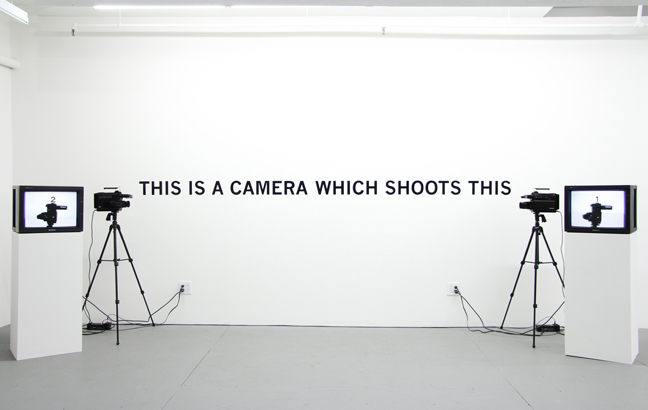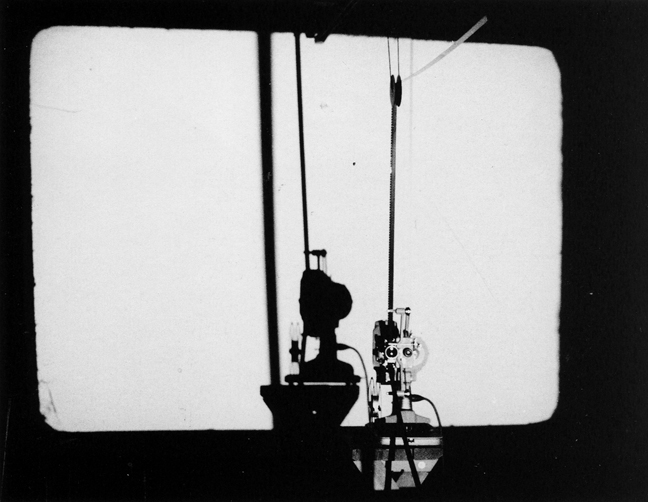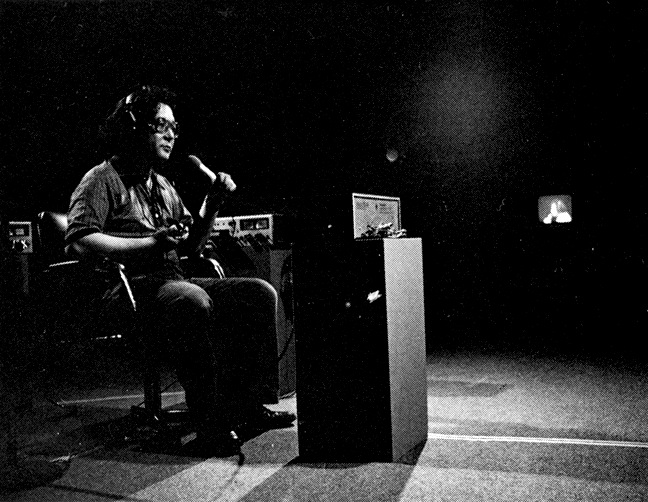Takahiko Iimura
Seeing Double
April 8 – May 15, 2016
Opening Friday April 8, 6-9pm

Takahiko Iimura, “This Is A Camera Which Shoots This”, 1980, two video cameras, two video monitors, vinyl, dimensions variable – image courtesy of the artist
Microscope is honored to present “Seeing Double”, the second solo exhibition at the gallery by New York-based Japanese pioneering artist Takahiko Iimura, who has been actively making work for over five decades.
The exhibition takes a look back, concentrating on five seminal installation works made by the artist between 1964 and 1983 exhibited together for the first time. In different ways and with separate concerns, the works in “Seeing Double” each present elements of duality – sculptural, cultural, logical, visual and/or auditory – as a means to achieve unity, made possible through the mediums and apparatus of film and video.
Iimura, who arrived in New York in the mid 1960s after the critical success received by his film “AI (Love)” (1962, 16mm, soundtrack by Yoko Ono), foresaw the potentialities of film as an object and in expanded cinema performance – the first of which was presented in Tokyo in 1963 – and later those of analog video, made manifest in his works as early as 1970 and featured throughout the next decade at the Whitney Museum of American Art, Museum of Modern Art (MoMA), The Kitchen, and Centre Georges Pompidou, in Paris, among others.
“…While the intensity and the fire of the American avant-garde film movement inspired him [Iimura] and attracted him, his Japanese origins contributed decisively to his uncompromising explorations of cinema’s minimalist and conceptualist possibilities. He has explored this direction of cinema in greater depth than anyone else.” – Jonas Mekas
The centerpiece of “Seeing Double” is Iimura’s iconic “This is A Camera Which Shoots This” (1980), a video installation consisting of two video cameras and two monitors arranged in pairs opposite each other with the title sentence centered on the wall between them. In this work first exhibited in 1980 at Toyko’s American Center, Iimura creates a vicious logic cycle by redirecting the signals of the cameras so that each appears to be recording itself, emphasizing the instant playback possibilities of video that allow one to be simultaneously recording, recorded, and to watch the recording as it happens. Additionally, “This is A Camera Which Shoots This” continues and expands upon explorations of the semiotic differences between Japanese and Western cultures through the medium of video that Iimura began in the 70s.
“The English word ‘this’ can be both the subject and the object, and this depends on where the word is placed in the sentence and how it is framed. […] In video you can shoot at the same time as you project, where the camera as a subject simultaneously becomes the object, which correlates with this notion. In this way I showed the double identity of a camera and conveyed the correspondence between words and images.” – TI
Similarly, “Dead Movie” (1964) Iimura’s first film installation and the earliest work on view involves two 16mm projectors that are aimed at each other: one threaded with looping opaque black leader, the other film-less. With an interest in revealing what lies behind the projected image, the artist exposes the cinematic apparatus to create a work of contradictions in which the presence of film results in no projection, and its absence, in a full frame of projected light.

Takahiko Iimura, “Dead Movie”, 1964, two 16mm projectors, 16mm black leader, dimensions variable – image courtesy of the artist
The single-channel video “Self-Identity”, completed between 1972-1974 and partly inspired by the reading of Derrida’s 1967 essay “Speech and Phenomena”, is the first in a series of videos in which the artist records himself before the camera to examine the concept of identity, at a moment when video had just made recording oneself more easily accessible. In this work, Iimura uses the pronouns “I”, “you”, and “he/she” as spoken to the camera in-sync and off-sync to create the illusion of additional selves off screen. With a medium that allows for and is here intentionally used self-referentially to imply multiple identities, the artist is able to simultaneously affirm and negate his identity without contradicting himself.
“Iimura’s treatment of the live video image as a mirror of the self and language, a metaphor of image and word, creates a dialectic of gestalts in a radical exposure of the medium of video. An exposure of its technology in a recognition of the real and abstract mirror of the monitor’s screen, a post-modern “mirror phase” of technology […]” – John G. Hanhardt
Iimura’s 1983 monitor installation “TV for TV”, originally presented in Osaka and later exhibited in the 1994 Guggenheim Museum survey show “Japanese Art After 1945: Scream Against the Sky” consists of two identical and untuned TV monitors facing each other with their broadcasts, playing infinitely for an audience solely of each other.
The final work “Timed” (1972) is a rectangular wall installation composed of 20 rows of 16mm filmstrips – made from black and clear leader – of identical length corresponding to 10 seconds of time if projected at 24 frames per second. The combination of black and clear leader shifts in each row in an increment equivalent to 1 second of projection. As a whole the work is not only a tangible visualization of cinematic time but also of the opposing elements of darkness and light, essential constituents of cinema itself.
“Seeing Double” opens Friday April 8th, 6 to 9pm, and runs through May 15th, 2016. Gallery Hours: Thursday through Monday 1-6pm, or by appointment.
Microscope is also pleased to announce that Takahiko Iimura’s 1981 expanded cinema performance “Circle and Square” has been acquired by The Whitney Museum of American Art for its Permanent Collection.
For inquiries please contact the gallery by email at inquiries@microscopegallery.com or by phone at 347.925.1433.

“Timed” (1972) and “TV for TV” (1983) – Installation view
TAKAHIKO IIMURA, born in Tokyo in 1937, is a pioneering artist known for his work with film, video, installation, performance, and digital technologies spanning more than 50 years.
Iimura first began working with film in 1960, with themes such as eroticism and social criticism, and was instrumental in the burgeoning Japanese experimental and independent film scene. He quickly broadened his practice in 1963 to expanded cinema performance with “Dada 62” using 8mm film projected onto the walls of Tokyo’s Naiqua Gallery, and “Screen Play” presented at the Sogetsu Art Center in Toyko in which his 16mm film “Iro” (1963) is projected onto the back of a performer reading a newspaper.
The artist first received international attention in 1964 at the Knokke-Le-Zoute Experimental Film Festival in Belgium where he received a joint Special Prize and his film “Ai (LOVE)” (1962) caught the attention of Jonas Mekas who went on to praise the piece in the Village Voice and present the film the next year at his Film-makers’ Cinematheque. Inspired by the film’s reception and also encouraged by fellow Japanese artist Yoko Ono, who made the soundtrack for the piece, Iimura moved to the US on a Fellowship from Harvard University in 1966 and soon immersed himself in the mid-60s New York experimental film and art community.
Iimura’s first works in video date to 1970. His early videos were included in exhibitions at the Museum of Modern Art of New York and PS1 (1975), and Centre Georges Pompidou in Paris, France (1977), while other performance based works and interactive installations were featured in the 1979 two-person exhibition “New Video” (with Shigeko Kubota) at the Whitney Museum of American Art, New York. During this time, he also continued to work with film, moving toward more formal investigations of time and space using the filmstrip both as an object and through projection.
In 1981, the year the artist became a permanent resident of the US, his work was included at the Whitney Museum’s Biennial Exhibition. That same year, he debuted his punch hole film performance “Circle and Square” at Millennium Film Workshop. Other exhibitions of note in the 80s include “Video Art: A History” at MoMA, New York (1983) and the premiere of Iimura’s “MA: Space/Time in the Garden of Ryoan-Ji”, a commission by the “Program for Art on Film” of the Metropolitan Museum of Art and the J. Paul Getty Trust, at the Japan Society in 1989 and later screened at Metropolitan Museum of Art in New York and the Louvre Museum in Paris, among others. Nineteen eighty-nine was also the year Iimura’s book “New York Art Diary”, a personal account of his life in the city and the artistic scene was published.
In the 1990s, Iimura’s work was featured in several major exhibitions including “Japanese Art After 1945: Scream Against The Sky” (1994) at the Guggenheim Museum, and “The American Century, Part II” (1999-2000) at the Whitney Museum. During the 2000s, Iimura turned his focus to interactive computer-based art and semiology of video, while continuing to exhibit and perform in institutions and galleries in the US and abroad.
Recently, his work has seen a resurgence including a solo exhibition “Between The Frames” at Microscope Gallery (Brooklyn, NY) in 2011, early works presented in “Tokyo: Experiments in Music and Performance” (2013) at MoMA, New York, and “Throwing Shadows: Japanese Expanded Cinema in the Time of Pop” (2016), at the Tate Modern, London.
Among the institutions that have exhibited Iimura’s works are Anthology Film Archives, New York, NY; Film Society of Lincoln Center, New York, NY; Guggenheim Museum, New York, NY; Metropolitan Museum of Art, New York, NY; Museum of Modern Art, New York, NY; Whitney Museum of American Art, New York, NY; The Kitchen, New York, NY; Los Angeles County Museum of Art, Los Angeles, CA; Museum of Contemporary Art (MOCA), Los Angeles, CA; Pacific Film Archive, Berkley, CA; Walker Art Center, Minneapolis, MI; Carnegie Art Museum, Pittsburgh, PA; Cinémathèque Française, Paris, France; Centre Georges Pompidou, Paris, France; Musée d’Art Moderne, Paris, France; Jeu de Paume, Paris, France; Tate Modern, London, UK; Serpentine Galleries, London, UK; Institute of Contemporary Arts (ICA), London, UK; Hara Museum of Contemporary Art, Tokyo, Japan; National Art Center, Tokyo, Japan; Tokyo Metropolitan Museum of Photography, Tokyo, Japan; Tokyo Metropolitan Art Museum, Tokyo, Japan; Arsenal, Berlin, Germany; Filmmuseum, Munich, Germany; Museo Nacional Centro de Arte Reina Sofia, Madrid, Spain.
Fellowships include: Rockefeller Foundation (2001); New York State Council for the Arts (2001); Japan Arts Fund, Tokyo (1994, 1997, 1998, 2000); New York Foundation for the Arts, New York (1986); Japan Foundation, Tokyo (1982, 1985, 1989, 1992); Canada Council, Ottawa (1981); German Academic Exchange Service (DAAD), Berlin (1972); The Japan Society (1966-68); Harvard University Fellowship (1966); among numerous others.
Iimura’s work is in the Collections of the Metropolitan Museum of Art, New York; Everson Museum of Art, Syracuse, NY; Fondazione La Biennale di Venezia, Venice, Italy; Centre Georges Pompidou, Paris, France; Museo Nacional Centro de Arte Reina Sofia, Madrid, Spain; Neuer Berliner Kunstverein, Berlin, Germany; Tokyo Metropolitan Art Museum, Tokyo, Japan; Hara Museum of Contemporary Art, Tokyo, Japan; among others.
Takahiko Iimura currently lives and works in New York and is represented by Microscope Gallery in Brooklyn, New York.

Takahiko Iimura at the Whitney Museum of American Art, New York, 1979 – image courtesy of the artist
